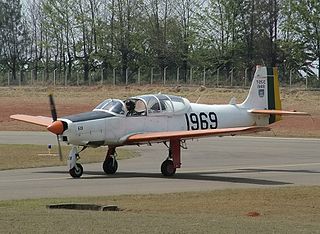
The Piper PA-23, named Apache and later Aztec, is a four- to six-seat twin-engined light aircraft aimed at the general-aviation market. The United States Navy and military forces in other countries also used it in small numbers. Originally designed in the 1950s by the Stinson Aircraft Company, Piper Aircraft manufactured the Apache and a more powerful version, the Aztec, in the United States from the 1950s to the 1980s.

The Piper PA-24 Comanche is an American four-seat or six-seat, low-wing, all-metal, light aircraft of semimonocoque construction with tricycle retractable landing gear. Piper Aircraft designed and developed the Comanche, which first flew on May 24, 1956. Together with the PA-30 and PA-39 Twin Comanches, it made up the core of the Piper Aircraft lineup until the production lines for both aircraft were destroyed in the 1972 Lock Haven flood.

The Aermacchi AM.3 was the result of a joint venture between Aermacchi and Aeritalia in response to an Italian Army requirement for an aircraft to replace the Cessna L-19, and was initially designated the MB-335.

The Britten-Norman BN-2 Islander is a British light utility aircraft and regional airliner designed and originally manufactured by Britten-Norman of the United Kingdom. Still in production, the Islander is one of the best-selling commercial aircraft types produced in Europe. Although designed in the 1960s, over 750 are still in service with commercial operators around the world. The aircraft is a light transport with over 30 military aviation operators around the world.

The Valmet L-70 Vinka is a Finnish-designed piston-powered military basic trainer aircraft of the 1970s. A production run of 30 aircraft were built for the Finnish Air Force in the early 1980s, and although the type was not exported, it formed the basis of the turboprop-powered Aermacchi M-290 RediGO.

The CAP Aviation CAP-23x family is a family of aircraft designed for competition aerobatics. The CAP 230 airframe was a direct development of the CAP 21 competition single seater strengthened to cope with a 300 hp (220 kW) 6-cylinder Lycoming AEIO-540 engine instead of the 200 hp (150 kW) original 4-cylinder Lycoming AEIO-360.

The Piper PA-30 Twin Comanche is an American twin-engined cabin monoplane designed and built by Piper Aircraft. It was a twin-engined development of the PA-24 Comanche single-engined aircraft. A variant with counter-rotating propellers was designated the Piper PA-39 Twin Comanche C/R.

The Piper PA-44 Seminole is an American twin-engined light aircraft manufactured by Piper Aircraft.

The Piper PA-18 Super Cub is a two-seat, single-engine monoplane. Introduced in 1949 by Piper Aircraft, it was developed from the Piper PA-11, and traces its lineage back through the J-3 to the Taylor E-2 Cub of the 1930s. In close to 40 years of production, over 10,000 were built. Super Cubs are commonly found in roles such as bush flying, banner towing and glider towing.

The Cessna 414 is an American light, pressurized, twin-engine transport aircraft built by Cessna. It first flew in 1968 and an improved variant was introduced from 1978 as the 414A Chancellor.

The Beechcraft Queen Air is a twin-engined light aircraft produced by Beechcraft in several versions from 1960 to 1978. Based upon the Twin Bonanza, with which it shared key components such as wings, engines, and tail surfaces, but featuring a larger fuselage, it served as the basis for the highly successful King Air series of turboprop aircraft. It is often used as a private aircraft, a utility, or a small commuter airliner. Production ran for 17 years.

The PAC MFI-17 Mushshak is a license-built fixed-gear basic trainer aircraft manufactered by PAC. An improved version of the Saab Safari (MFI-15), the MFI-17 is manufactured in Kamra, Pakistan by Pakistan Aeronautical Complex (PAC). Built to Mil-Spec and fully aerobatic, it is used for training, towing and other ground support roles. An upgraded version, the PAC Super Mushshak, has also been produced by PAC. As of 2022, there were 477 MFI-15/17/395 in use, making it one of the most commonly used training aircraft in the world.
Valmet L-80 TP Turbo-Vinha was a prototype for a new Finnish turboprop basic trainer aircraft. The aircraft, which carried the designation OH-VBB, was destroyed in a crash in 1985, killing the test pilot Paavo Janhunen. The aircraft was a further development of the Valmet L-70 Vinka and would eventually lead to the Valmet L-90 Redigo.

The Piaggio P.166 is an Italian twin-engine pusher-type utility aircraft developed by Piaggio Aero. The aircraft model name was Portofino, and is also known as Albatross in South African military service.

The Neiva N621 Universal is a Brazilian propeller-driven basic trainer and ground attack aircraft manufactured by Indústria Aeronáutica Neiva. It is a cantilever, low-wing monoplane of all-metal construction, with retractable undercarriage and side-by-side seating.

The Sharp Nemesis NXT is a sport-class kit-built aircraft, designed for air racing. It was designed by Nemesis Air Racing's president Jon Sharp, as a follow-on to their Sharp Nemesis. It is a two-seat, single engine, low wing, retractable gear kit aircraft. As designed, the aircraft is powered by a Lycoming TIO-540-NXT Thunderbolt six-cylinder engine.

The Lake Buccaneer is an American four-seat, light amphibious aircraft derived from the Colonial C-2 Skimmer, itself a development of the three-seat Colonial C-1 Skimmer.

The Scintex ML 250 Rubis was a French civil utility aircraft of the 1960s.
The Alpha J-5 Marco is a single-seat airplane in pod-and-boom pusher configuration. Kits were built in Poland and the aircraft has been exported to several countries including Germany and the USA.

The I.S.T. XL-15 Tagak was a single-engine, twin-boom, high-wing monoplane designed after the I.S.T. XL-14 Maya and built in the Philippines in the mid-1950s. The result of a collaboration between a Government research institute and the Philippine Air Force, it was designed as a utility, liaison or ambulance aircraft and as a test bed for the use of local materials in aviation.




















